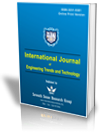Prediction of Birth Weight Using Machine Learning Models
Prediction of Birth Weight Using Machine Learning Models |
||
 |
 |
|
| © 2025 by IJETT Journal | ||
| Volume-73 Issue-4 |
||
| Year of Publication : 2025 | ||
| Author : Keerthana P, Sasidhar Babu Suvanam |
||
| DOI : 10.14445/22315381/IJETT-V73I4P136 | ||
How to Cite?
Keerthana P, Sasidhar Babu Suvanam, "Prediction of Birth Weight Using Machine Learning Models," International Journal of Engineering Trends and Technology, vol. 73, no. 4, pp.440-452, 2025. Crossref, https://doi.org/10.14445/22315381/IJETT-V73I4P136
Abstract
The study focuses on the fetal birthweight using machine learning (ML) based prediction models. The software used for this research is Python, which is used to design and implement the birthweight forecasting model. The model developed uses six different regression models, using Linear, Ridge, ElasticNet, SVM, XGB and Ensemble (XGB+GB) models, respectively. The performances of each regression model are evaluated using R2 estimation. The results show that the ensemble model achieved a higher accuracy level of 90% (.9039392149835611), whereas the other five models obtained less than 80%. The accuracy achieved by the elastic-net model is 34%, ridge and linear models are 39%, the SVM mode gained 42.9%, and the XGB model achieved 77.7%. From the findings, it is proven that the XGB+GB ensemble model obtained higher accuracy with better performance. Thus, from the results, it can be concluded that the ensemble model is more efficient in accurately predicting the birth weight of fetuses than other traditional models.
Keywords
Birthweight, Ensemble model, Fetal birthweight prediction, Fetuses birthweight prediction, Regression models, R squared estimation.
References
[1] Deping Hu et al., “Inclusion of Machine Learning Kernel Ridge Regression Potential Energy Surfaces in On-the-Fly Nonadiabatic Molecular Dynamics Simulation,” The Journal of Physical Chemistry Letters, vol. 9, no. 11, pp. 2725-2732, 2018.
[CrossRef] [Google Scholar] [Publisher Link]
[2] Tasneem Binte Reza, and Nahid Salma, “Prediction and Feature Selection of Low Birth Weight Using Machine Learning Algorithms,” Journal of Health, Population and Nutrition, vol. 43, no. 1, pp. 1-13, 2024.
[CrossRef] [Google Scholar] [Publisher Link]
[3] Jagjit S. Teji et al., “Neoai 1.0: Machine Learning-Based Paradigm for Prediction of Neonatal and Infant Risk of Death,” Computers in Biology and Medicine, vol. 147, 2022.
[CrossRef] [Google Scholar] [Publisher Link]
[4] M. Poongodi et al., “New York City Taxi Trip Duration Prediction Using MLP and XGBoost,” International Journal of System Assurance Engineering and Management, vol. 13, no. S1, pp. 16-27, 2021.
[CrossRef] [Google Scholar] [Publisher Link]
[5] Alfensi Faruk et al., “Prediction and Classification of Low-Birth-Weight Data Using Machine Learning Techniques,” Indonesian Journal of Science and Technology, vol. 3, no. 1, pp. 18-28, 2018.
[Google Scholar] [Publisher Link]
[6] Amene Ranjbar et al., “Machine Learning-Based Approach for Predicting Low Birth Weight,” BMC Pregnancy and Childbirth, vol. 23, no. 1, pp. 1-7, 2023.
[CrossRef] [Google Scholar] [Publisher Link]
[7] S. Ramraj et al., “Experimenting Xgboost Algorithm for Prediction and Classification of Different Datasets,” International Journal of Control Theory and Applications, vol. 9, no. 40, pp. 651-662, 2016.
[Google Scholar]
[8] Khushbu Kumari, and Suniti Yadav, “Linear Regression Analysis Study,” Journal of the Practice of Cardiovascular Sciences, vol. 4, no. 1, pp. 33-36, 2018.
[CrossRef] [Google Scholar] [Publisher Link]
[9] Christopher Freyder, “Using Linear Regression and Mixed Models to Predict Health Care Costs After an Inpatient Event,” Master's Thesis, University of Pittsburgh, pp. 1-43, 2016.
[Google Scholar] [Publisher Link]
[10] Rahul Pathak et al., “Infant Weight Prediction Using Multivariate Linear Regression,” International Journal of Research and Analytical Reviews, vol. 5, no. 4, pp. 158-164, 2018.
[Google Scholar]
[11] S.S. Pooja, and Gladrene Sheena Basil, “Students Performance Prediction and Classification Using Ridge Regression Algorithm,” International Journal of Advanced Trends in Engineering and Management, vol. 8, no. 112, pp. 1006-1014, 2023.
[Publisher Link]
[12] Saleem Adeeba, Banujan Kuhaneswaran, and B.T.G.S. Kumara “Prediction of Weight Range of Neonate Using Machine Learning Approach,” 2022 International Conference on Innovations in Science, Engineering and Technology, Chittagong, Bangladesh, pp. 427-432, 2022.
[CrossRef] [Google Scholar] [Publisher Link]
[13] Wessel N. van Wieringen, “Lecture Notes on Ridge Regression,” Arxiv, pp. 1-149, 2015.
[CrossRef] [Google Scholar] [Publisher Link]
[14] Gaurav Kumar et al., “Application of Machine Learning in Predicting the Yield Strength of API Steels,” European Chemical Bulletin, vol. 12, no. 7, pp. 1639-1653, 2023.
[Publisher Link]
[15] Dina A. Alabbad et al., “Birthweight Range Prediction and Classification: A Machine Learning-Based Sustainable Approach,” Machine Learning and Knowledge Extraction, vol. 6, no. 2, pp. 770-788, 2024.
[CrossRef] [Google Scholar] [Publisher Link]
[16] Mohammed Al-Shawwa, and Samy S. Abu-Naser, “Predicting Birth Weight Using Artificial Neural Network,” International Journal of Academic Health and Medical Research, vol. 3, no. 1, pp. 9-12, 2019.
[Google Scholar] [Publisher Link]
[17] Chen Bo et al., “A Method for Estimating Fetal Weight Based on Body Composition,” The Journal of Maternal-Fetal & Neonatal Medicine, vol. 32, no. 19, pp. 3306-3314, 2019.
[CrossRef] [Google Scholar] [Publisher Link]
[18] Cheng Gao et al., “Deep Learning Predicts Extreme Preterm Birth from Electronic Health Records,” Journal of Biomedical Informatics, vol. 100, 2019.
[CrossRef] [Google Scholar] [Publisher Link]
[19] Pradeeba Sridar et al., “Decision Fusion-Based Fetal Ultrasound Image Plane Classification Using Convolutional Neural Networks,” Ultrasound in Medicine & Biology, vol. 45, no. 5, pp. 1259-1273, 2019.
[CrossRef] [Google Scholar] [Publisher Link]
[20] Zakir Hussain, and Malaya Dutta Borah, “Birth Weight Prediction of Newborn Baby with Application of Machine Learning Techniques on Features of Mother,” Journal of Statistics and Management Systems, vol. 23, no. 6, pp. 1079-1091, 2020.
[CrossRef] [Google Scholar] [Publisher Link]
[21] Yu Lu et al., “Ensemble Machine Learning for Estimating Fetal Weight at Varying Gestational Age,” Proceedings of the AAAI Conference on Artificial Intelligence, vol. 33, no. 1, pp. 9522-9527, 2019.
[CrossRef] [Google Scholar] [Publisher Link]
[22] Emily J. MacKay et al., “Application of Machine Learning Approaches to Administrative Claims Data to Predict Clinical Outcomes in Medical and Surgical Patient Populations,” PLoS One, vol. 16, no. 6, pp. 1-14, 2021.
[CrossRef] [Google Scholar] [Publisher Link]
[23] Zahra Hoodbhoy et al., “Use of Machine Learning Algorithms for Prediction of Fetal Risk Using Cardiotocographic Data,” International Journal of Applied and Basic Medical Research, vol. 9, no. 4, pp. 226-230, 2019.
[CrossRef] [Google Scholar] [Publisher Link]
[24] Nabillah Rahmayanti et al., “Comparison of Machine Learning Algorithms to Classify Fetal Health Using Cardiotocogram Data,” Procedia Computer Science, vol. 197, pp. 162-171, 2022.
[CrossRef] [Google Scholar] [Publisher Link]
[25] Oliver Campos Trujillo, Jorge Perez-Gonzalez, and Verónica Medina-Bañuelos, “Early Prediction of Weight at Birth Using Support Vector Regression,” VIII Latin American Conference on Biomedical Engineering and XLII National Conference on Biomedical Engineering, Cancún, México, pp. 37-41, 2019.
[CrossRef] [Google Scholar] [Publisher Link]
[26] Miao Feng et al., “Fetal Weight Estimation via Ultrasound Using Machine Learning,” IEEE Access, vol. 7, pp. 87783-87791, 2019.
[CrossRef] [Google Scholar] [Publisher Link]
[27] Wasif Khan et al., “Infant Birth Weight Estimation and Low Birth Weight Classification in United Arab Emirates Using Machine Learning Algorithms,” Scientific Reports, vol. 12, no. 1, pp. 1-12, 2022.
[CrossRef] [Google Scholar] [Publisher Link]
[28] Elena Quatrini et al., “Machine Learning for Anomaly Detection and Process Phase Classification to Improve Safety and Maintenance Activities,” Journal of Manufacturing Systems, vol. 56, pp.117-132, 2020.
[CrossRef] [Google Scholar] [Publisher Link]
[29] Wondesen Teshome Bekele, “Machine Learning Algorithms for Predicting Low Birth Weight in Ethiopia,” BMC Medical Informatics and Decision Making, vol. 22, no. 1, pp. 1-16, 2022.
[CrossRef] [Google Scholar] [Publisher Link]
[30] Mahya Arayeshgari et al., “Machine Learning-Based Classifiers for the Prediction of Low Birth Weight,” Healthcare Informatics Research, vol. 29, no. 1, pp. 54-63, 2023.
[CrossRef] [Google Scholar] [Publisher Link]
[31] Jung Ho Han et al., “Application of Machine Learning Approaches to Predict Postnatal Growth Failure in Very Low Birth Weight Infants,” Yonsei Medical Journal, vol. 63, no. 7, pp. 640-647, 2022.
[CrossRef] [Google Scholar] [Publisher Link]
[32] Wei-Ting Lin et al., “Predicting in-Hospital Length of Stay for Very-Low-Birth-Weight Preterm Infants Using Machine Learning Techniques,” Journal of the Formosan Medical Association, vol. 121, no. 6, pp. 1141-1148, 2022.
[CrossRef] [Google Scholar] [Publisher Link]
[33] P. Thabrez, and J. Srinivasan, “A Novel Approach Low Birth Weight Prediction Using Machine Learning Techniques,” International Journal of Scientific Research in Computer Science, Engineering and Information Technology, vol. 8, no. 4, pp. 272-276, 2022.
[Google Scholar] [Publisher Link]
[34] S.M. Ashikul Islam Pollob et al., “Predicting Risks of Low Birth Weight in Bangladesh with Machine Learning,” PLoS One, vol. 17, no. 5, pp. 1-12, 2022.
[CrossRef] [Google Scholar] [Publisher Link]
[35] Jing Tao et al., “Fetal Birthweight Prediction with Measured Data by a Temporal Machine Learning Method,” BMC Medical Informatics and Decision Making, vol. 21, no. 1, pp. 1-10, 2021.
[CrossRef] [Google Scholar] [Publisher Link]
[36] Ashis CU Denver, Birth Weight Prediction, Kaggle, 2021. [Online]. Available: https://www.kaggle.com/c/birth-weight-prediction
[37] Davide Chicco, Matthijs J. Warrens, and Giuseppe Jurman, “The Coefficient of Determination R-Squared Is More Informative Than SMAPE, MAE, MAPE, MSE and RMSE in Regression Analysis Evaluation,” PeerJ Computer Science, vol. 7, pp. 1-24, 2021.
[CrossRef] [Google Scholar] [Publisher Link]
[38] Candice Bentéjac, Anna Csörgő, and Gonzalo Martínez-Muñoz, “A Comparative Analysis of Gradient Boosting Algorithms,” Artificial Intelligence Review, vol. 54, no. 3, pp. 1937-1967, 2021.
[CrossRef] [Google Scholar] [Publisher Link]
[39] Niaz Muhammad Shahani et al., “Developing an Xgboost Regression Model for Predicting Young’s Modulus of Intact Sedimentary Rocks for the Stability of Surface and Subsurface Structures,” Frontiers in Earth Science, vol. 9, pp. 1-13, 2021.
[CrossRef] [Google Scholar] [Publisher Link]
[40] Tianqi Chen, and Carlos Guestrin, “Xgboost: A Scalable Tree Boosting System,” Proceedings of the 22nd ACM SIGKDD International Conference on Knowledge Discovery and Data Mining, San Francisco, California, USA, pp. 785-794, 2016.
[CrossRef] [Google Scholar] [Publisher Link]
[41] Jörg Henseler, Christian M. Ringle, and Rudolf R. Sinkovics, “The Use of Partial Least Squares Path Modeling in International Marketing,” New Challenges to International Marketing, vol. 20, pp. 277-319, 2009.
[CrossRef] [Google Scholar] [Publisher Link]
[42] Hemlata Sharma, Hitesh Harsora, and Bayode Ogunleye, “An Optimal House Price Prediction Algorithm: XGBoost,” Analytics, vol. 3, no. 1, pp. 30-45, 2024.
[CrossRef] [Google Scholar] [Publisher Link]

